Have you ever wondered how best to handle your chin? Well, wonder no more! Here’s a quick video to help guide you on your start to safely holding, transporting, and handling your chinchilla.
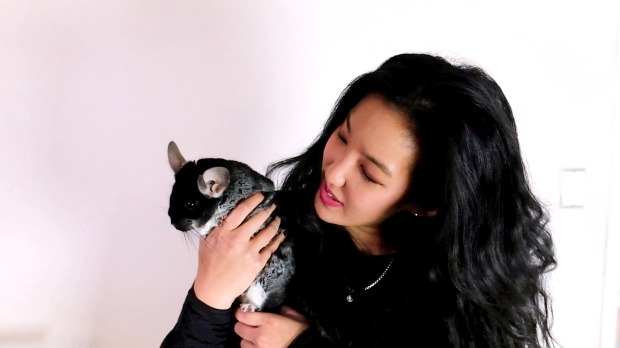

Have you ever wondered how best to handle your chin? Well, wonder no more! Here’s a quick video to help guide you on your start to safely holding, transporting, and handling your chinchilla.
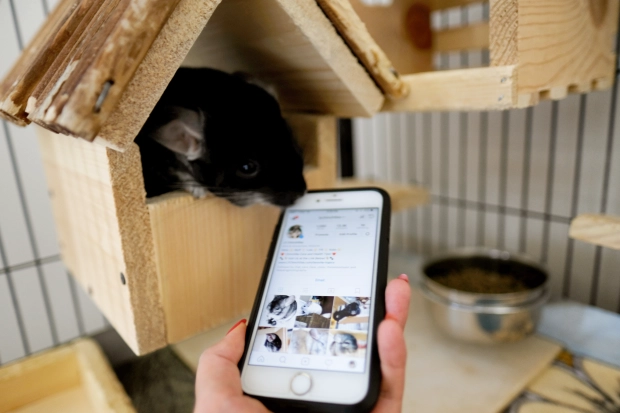
While photographing chinchillas can be challenging, its rewards are adorable and its cuteness nearly unmatched. However, aside from taking your chinchilla photography to the next level through creating adorable sets, there is another medium which is much more true-to-life and far more engaging: videography.
Chinchilla videos allow for additional dimensions of sharing: movement, sounds, and quirky personalities shine! But creating and editing videos is a time-consuming process that may seem daunting for new videographers. No fret – I’ll help you break down the requisites to create compelling pet videos without getting overwhelmed. There are a few steps to consider when it comes to the video-creation process: conceptualization, setup, videoing, post-production, and sharing. Read on, and you’ll be creating delightful videos in no time!
There are a few steps to consider when it comes to the video-creation process: conceptualization, setup, videoing, post-production, and sharing. Read on, and you’ll be creating delightful videos in no time!
Each great video starts with an epic theme: cuteness. But the question is, what kind of cuteness do you want to capture? Sometimes it’s fun to play into a certain theme or creative concept, such as “Paranormal Chintivity” or “CHINN Breaking News: Ebola Cure Found,” there’s always room in the webiverse for no-frills, simple shots of your adorable fluffballs. While creating sets and developing themes is always fun, don’t forget to manage expectations. Every single set I’ve created for the fluffs has been thoroughly destroyed by the end of filming – and certainly, with all the destruction and re-takes, these videos require more post-production than a simple scene. If you’re just starting out, simplicity is key. A well-lit room (I prefer natural light always, but artificial light is also helpful when needed) and a chin-comfortable environment are the two must-haves for your chin’s YouTube success.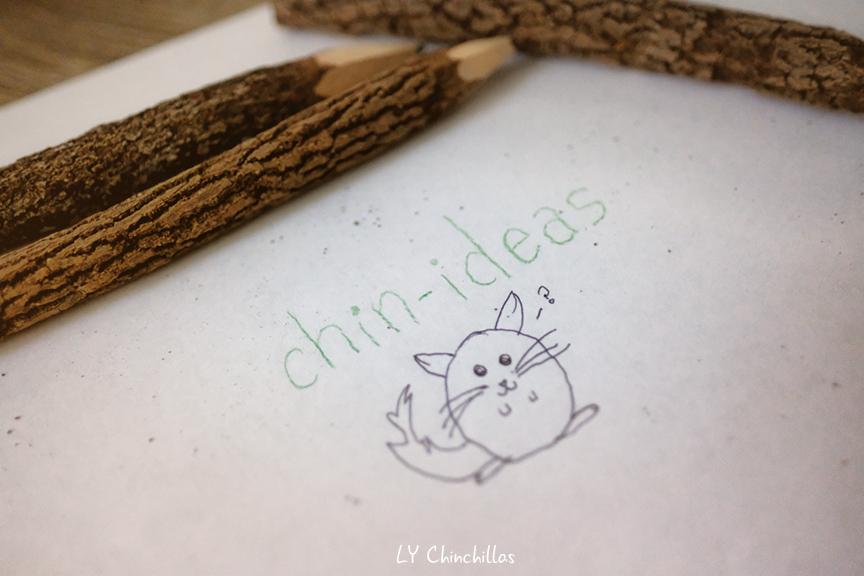 Another important question to ask is: how well do you know your chinchillas? Of course there will always be natural variables to every chinchilla’s behavior, but you should be in a comfortable enough place in bonding and learning your chin’s general demeanor. For example, I’d say “Muff’s not going to do well in a large, unconfined area. He’s a speed demon on the open road!” or “Koko Bear loves cuddling and massages. She’ll be a perfect cuddle or scratchies video subject!” or “Lulu and Fifi are wildcards! It’s pretty safe to say they’ll be little troublemakers on a hand-crafted set,” or “Mitty is an intelligent divo. He’s going to either give us incredible angles or ignore the camera entirely… likely a mix of both.” These kinds of insights into your fluffy ones will be the foundation upon which your video relies. Pick a personality and a setting to fit.
Another important question to ask is: how well do you know your chinchillas? Of course there will always be natural variables to every chinchilla’s behavior, but you should be in a comfortable enough place in bonding and learning your chin’s general demeanor. For example, I’d say “Muff’s not going to do well in a large, unconfined area. He’s a speed demon on the open road!” or “Koko Bear loves cuddling and massages. She’ll be a perfect cuddle or scratchies video subject!” or “Lulu and Fifi are wildcards! It’s pretty safe to say they’ll be little troublemakers on a hand-crafted set,” or “Mitty is an intelligent divo. He’s going to either give us incredible angles or ignore the camera entirely… likely a mix of both.” These kinds of insights into your fluffy ones will be the foundation upon which your video relies. Pick a personality and a setting to fit.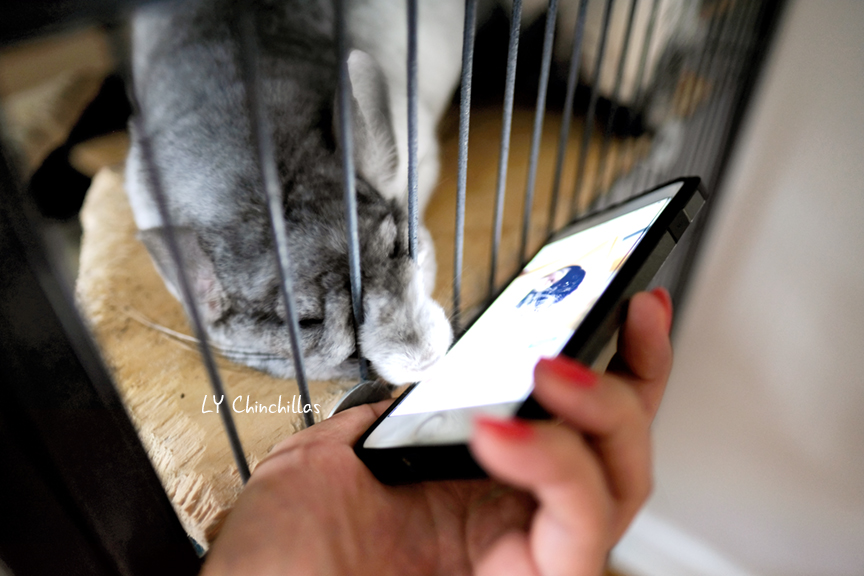
If you’re just starting out, it’s a great idea to start out in-cage to prevent your chinchilla from behaving sporadically due to being filmed in a new environment. Try to pick a time of day where your chin will be between sleepy and feisty – normally, midday works pretty well, between naps. This will also allow for the most amount of natural night for filming.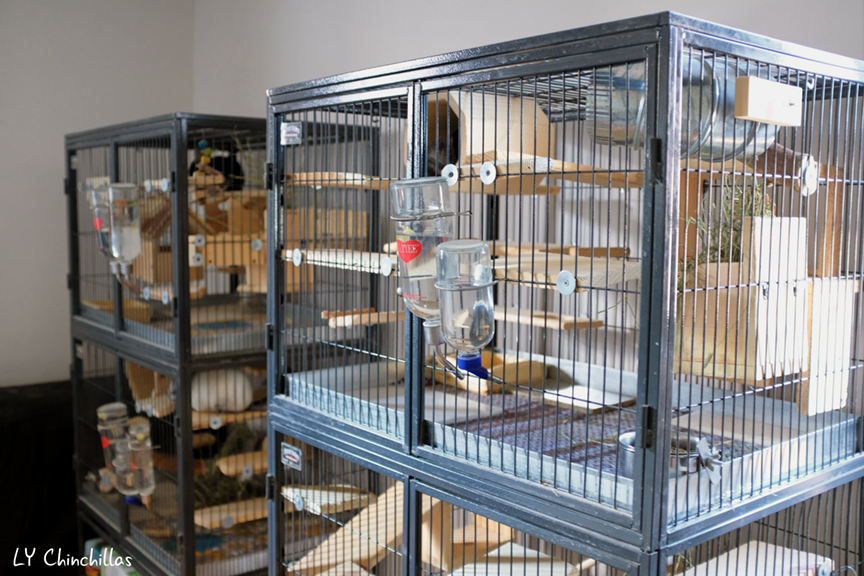 After a while, if you’ve become comfortable with in-cage videoing, you can start to get a bit more creative by moving your set to another area of the house. Great places are confined playroom areas such as closets, bathrooms, and other properly chinchilla-proofed spaces.
After a while, if you’ve become comfortable with in-cage videoing, you can start to get a bit more creative by moving your set to another area of the house. Great places are confined playroom areas such as closets, bathrooms, and other properly chinchilla-proofed spaces.
In order to put as much of the focus as possible on your little best friend, it’s important to make sure each area is as clean as possible. If in-cage, take the time to clean. If out-of-cage, same thing (+ chin-proofing). It may seem redundant and unnecessary, but the filming process and final output will thank you!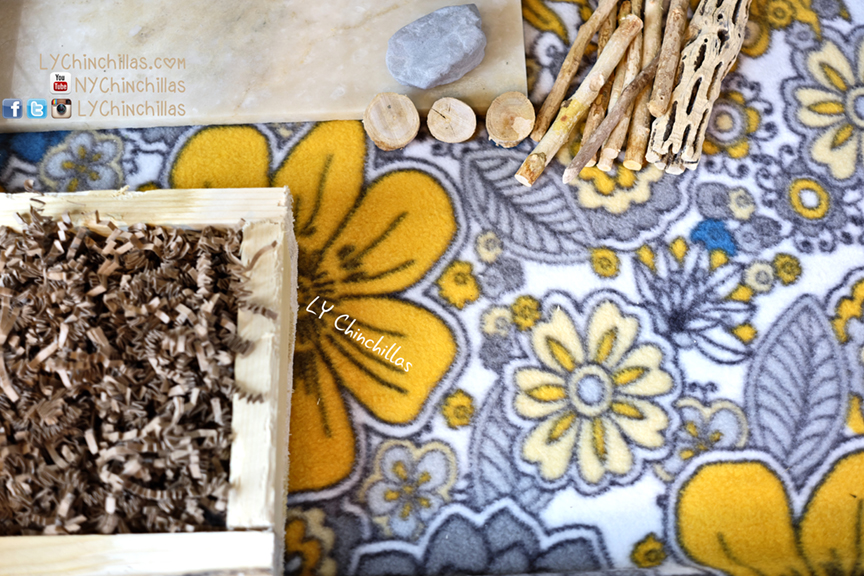
There are plenty of options when it comes to the best gear to choose. Of course, still photography is one thing. Videography may seem similar, but there are a few more factors to consider with regards to this medium: ease of use and desired output.
While the bulk of our current YouTube videos are created with the latest iPhones, I have been taking more time and energy to create more beautiful and artistic videos with the 4K options that FUJIFILM X Series cameras have to offer. My go-to camera choices for video capture is the FUJIFILM X-T2 or X-T20, both boasting beautiful 4K with film simulation overlay options. I love the X-T20’s touchscreen LCD focus, which makes capturing moving fluffballs as much of a breeze as possible. Both options are mirrorless, meaning they’re lighter and easier to use than DSLRs.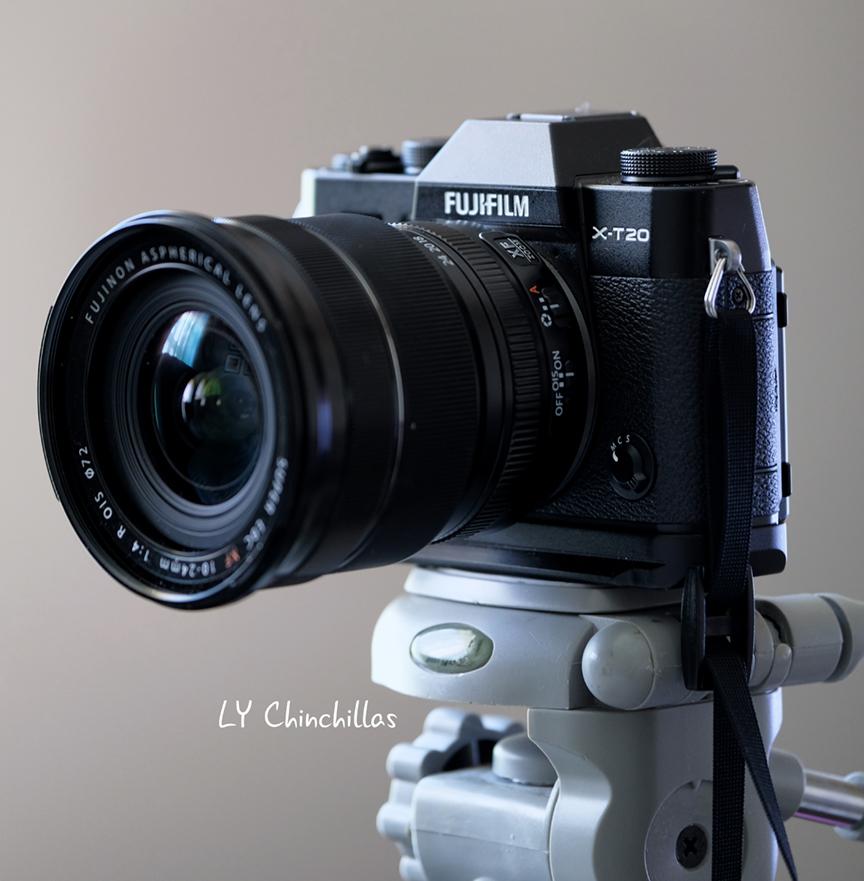 A few of my favorite lenses for creating lovely video shots are the XF50mmF2 and XF16mmF1.4 for cinematic vibes. If you need an extra hand, try using a tripod to help steady your takes. I also love the XF10-24mmF4 and XF50-140mmF2.8 for the epic OIS (optical image stabilization), which minimizes shakiness (typical to iPhone output), and diversity of focal lengths in the zooms. If you’re working alone, OIS will come in handy when you’re shooting handheld.
A few of my favorite lenses for creating lovely video shots are the XF50mmF2 and XF16mmF1.4 for cinematic vibes. If you need an extra hand, try using a tripod to help steady your takes. I also love the XF10-24mmF4 and XF50-140mmF2.8 for the epic OIS (optical image stabilization), which minimizes shakiness (typical to iPhone output), and diversity of focal lengths in the zooms. If you’re working alone, OIS will come in handy when you’re shooting handheld. 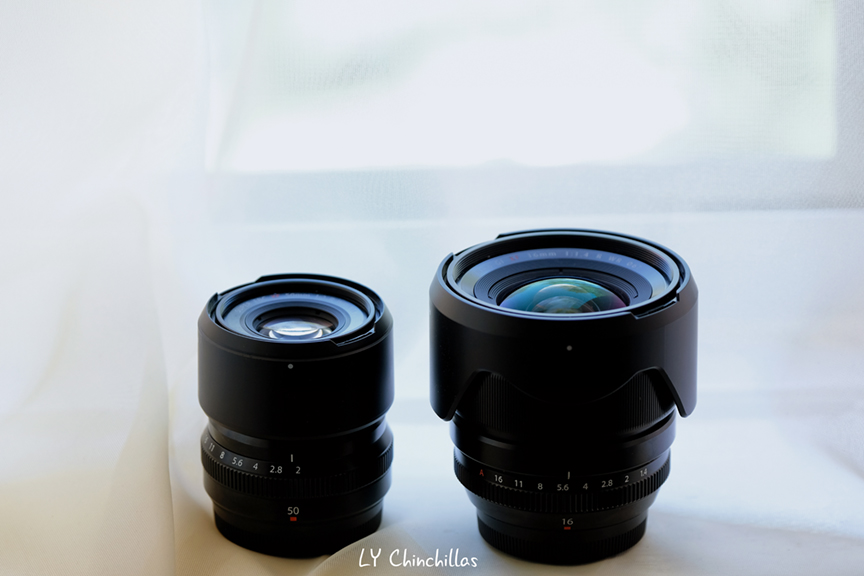 So, which option is best for you: a smartphone, or a professional camera? It comes down to what you’re comfortable with and what kind of feel you want to convey in your videos. Oftentimes, a phone is all that’s available when something supercute happens out of the blue – making it perfect for those quick snaps and adorable memories. However, if you’re putting the time into a concept and setup, you should consider a more professional system for more epic chinchilla videos.
So, which option is best for you: a smartphone, or a professional camera? It comes down to what you’re comfortable with and what kind of feel you want to convey in your videos. Oftentimes, a phone is all that’s available when something supercute happens out of the blue – making it perfect for those quick snaps and adorable memories. However, if you’re putting the time into a concept and setup, you should consider a more professional system for more epic chinchilla videos.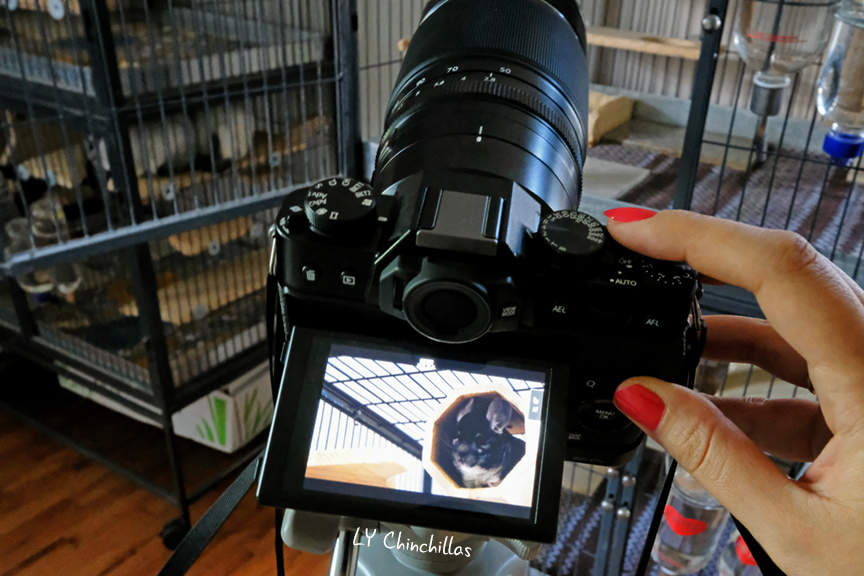 Gear aside, don’t get discouraged when you’re shooting – remember, there’s an inherent learning curve in all new and worthwhile endeavors. Try to time your filming on a treat day – don’t overindulge your chins, but if they’re on schedule for a treat, this is a great overlap. If you don’t get the shot, take a break and try again. If today’s not your day, maybe tomorrow is. Oftentimes, a patient and relaxed approach will yield the best possible results.
Gear aside, don’t get discouraged when you’re shooting – remember, there’s an inherent learning curve in all new and worthwhile endeavors. Try to time your filming on a treat day – don’t overindulge your chins, but if they’re on schedule for a treat, this is a great overlap. If you don’t get the shot, take a break and try again. If today’s not your day, maybe tomorrow is. Oftentimes, a patient and relaxed approach will yield the best possible results.
The easiest way to share is to simply upload your captured video to your favorite social website, no frills and no post-production. This also means no post-production: no color correction, frame adjustments, splicing/cropping, or intro/outros – but it sure does get your chinchilla’s cuteness out there as fast as possible!
While that’s an expeditious method, I’m going to dive a little deeper into your alternatives if you’re looking to invest a little more time and energy into your post.
Apple’s iMovie is one of my favorites: it’s incredibly easy to use, and the learning curve is very mild if you’re a regular smartphone user. This is how the bulk of our videos were created, and the software is certainly good enough for most videographers operating in the pet-video-creation realm.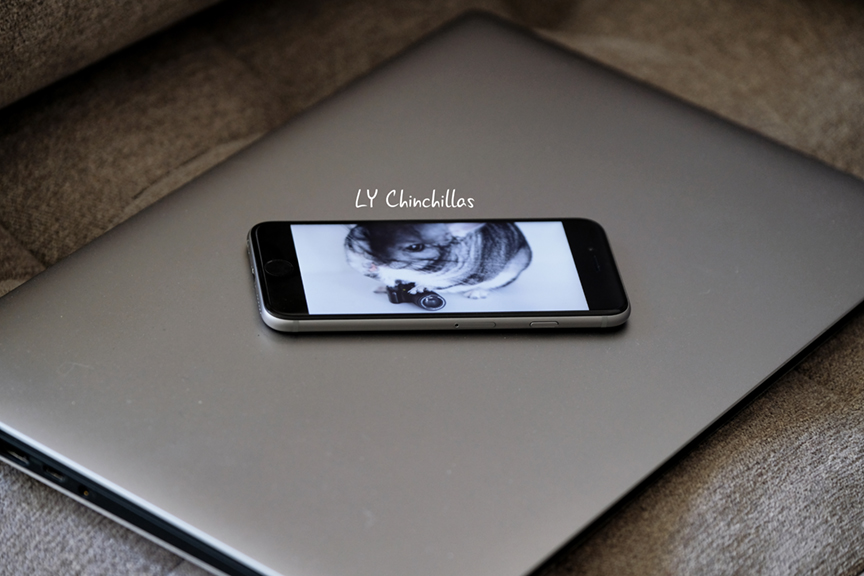 Final Cut Pro or Adobe Premiere Pro are great options for the more technically-savvy out there. These two are definitely professional grade software; a bit more difficult to learn than a simple interface like iMovie. However, it’s worth putting in the time, pulling up a few YouTube tutorials, and getting deeper into the edit! There are a lot more options in these types of technologies than a simpler interface can offer. To get started, a simple YouTube How-To search will get you where you need to go!
Final Cut Pro or Adobe Premiere Pro are great options for the more technically-savvy out there. These two are definitely professional grade software; a bit more difficult to learn than a simple interface like iMovie. However, it’s worth putting in the time, pulling up a few YouTube tutorials, and getting deeper into the edit! There are a lot more options in these types of technologies than a simpler interface can offer. To get started, a simple YouTube How-To search will get you where you need to go!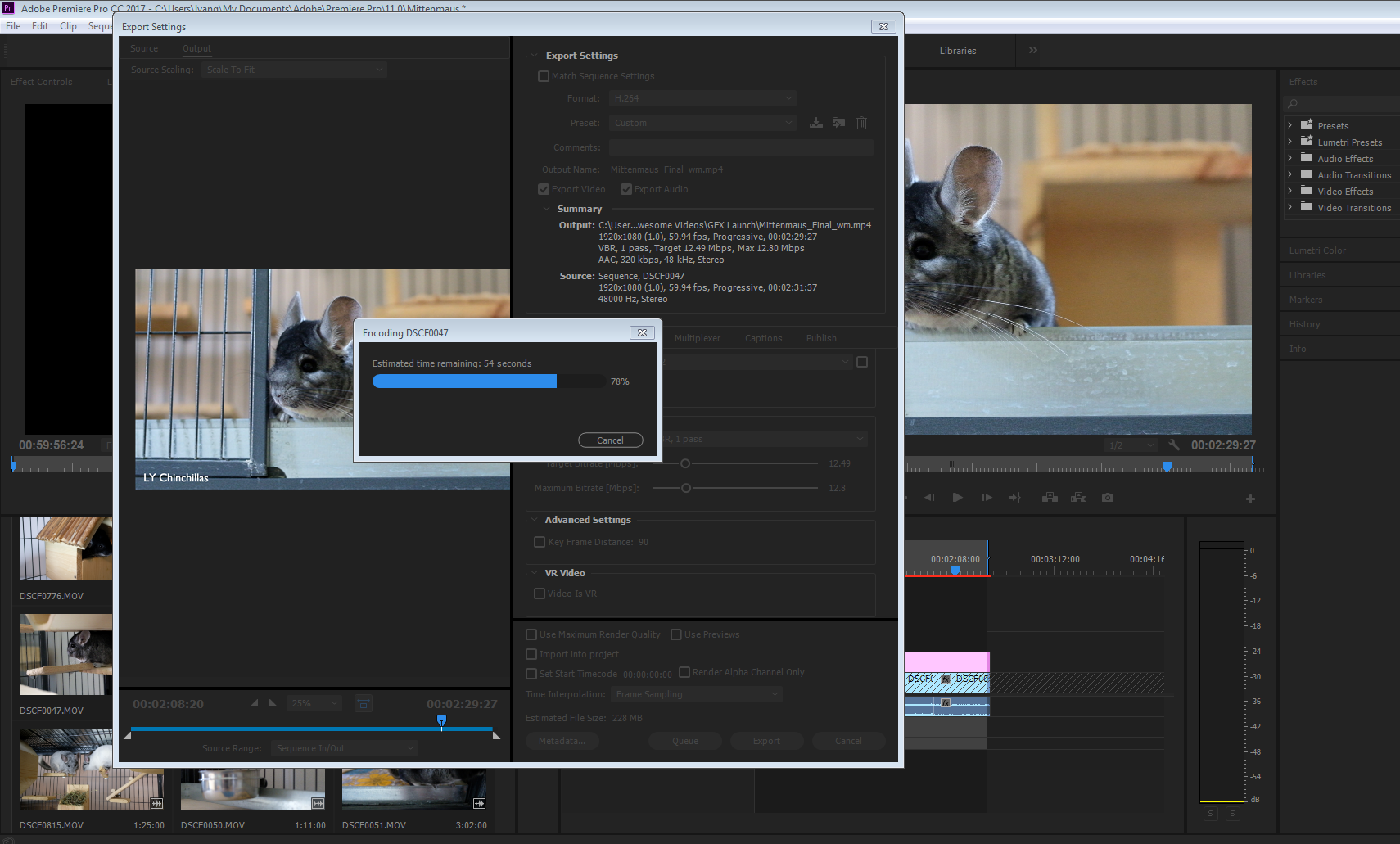 There are also a plethora of other post-production options out there, but those are the ones we’re comfortable with! If you have any other favorites, feel free to comment and share with us.
There are also a plethora of other post-production options out there, but those are the ones we’re comfortable with! If you have any other favorites, feel free to comment and share with us.
YouTube, Instagram, and Facebook are our all-time favorite sharing platforms. But, it’s really up to who you want to see your videos and how you want to share your chinchillas with the world. They’re definitely cute enough that they deserve to be shared, and you know it! Be sure to have fun and create a sense of community while you’re at it.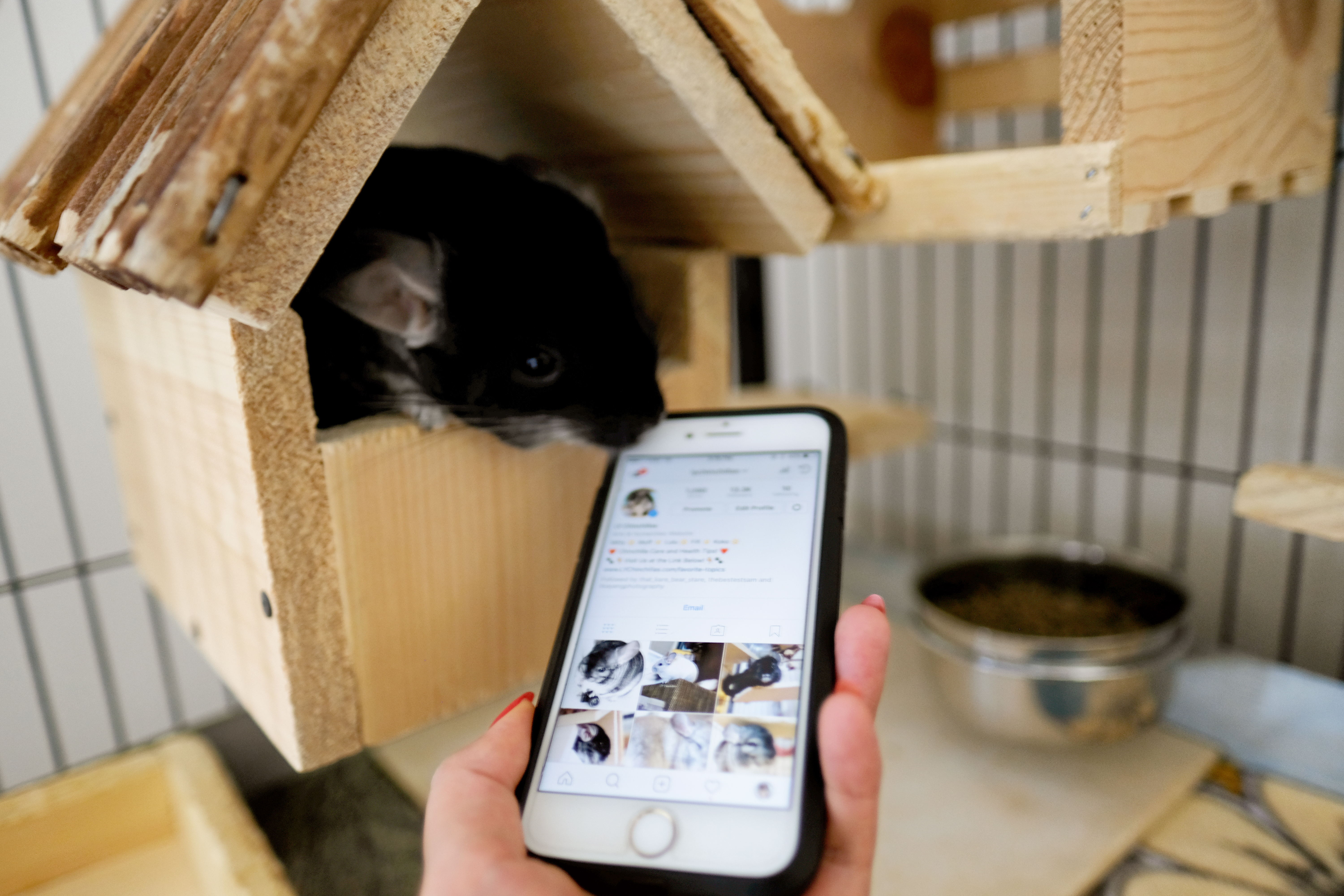
There you have it: the five simple steps to creating adorable chinchilla videos. Take this summer as a time to keep your chinchillas cool and creating even cooler videos! Don’t forget to check out our official YouTube channel here! There are a ton new videos on their way, just hit subscribe and enjoy the pawdorable fluffs. 🙂

LY Chinchillas Treat Donation
Donate healthy, delicious treats to LY Chinchillas to help keep our content going!
$5.00
This question comes up all the time from chinchilla owners, as it rightfully and naturally would. Should I get another chinchilla for my existing chinchilla(s)? Is my chinchilla lonely? Does my chinchilla deserve a playmate? Cage mate? Best friend?
The answer, unequivocally, is no. Well, it’s no and yes. Let me explain!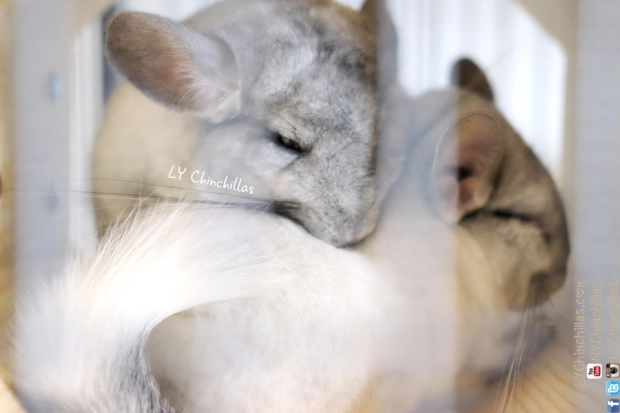 If you are a current chinchilla owner, you know that chinchillas are unique animals that are a true gift to the world! They have one-of-a-kind personalities with their own cute idiosyncrasies, adorable quirks, and delightful oddities that are distinct to each individual pet. This allows us to come to a few conclusions: 1. Chinchillas are particular, 2. Chinchillas are individualistic, and 3. Chinchilla behavior can sometimes be categorized as inexplicable. These reasonable conclusions – along with the fact that chins can be territorial – show us that the odds of one chinchilla getting along with another chinchilla is slim (depending on your chinchilla’s personality, of course).
If you are a current chinchilla owner, you know that chinchillas are unique animals that are a true gift to the world! They have one-of-a-kind personalities with their own cute idiosyncrasies, adorable quirks, and delightful oddities that are distinct to each individual pet. This allows us to come to a few conclusions: 1. Chinchillas are particular, 2. Chinchillas are individualistic, and 3. Chinchilla behavior can sometimes be categorized as inexplicable. These reasonable conclusions – along with the fact that chins can be territorial – show us that the odds of one chinchilla getting along with another chinchilla is slim (depending on your chinchilla’s personality, of course).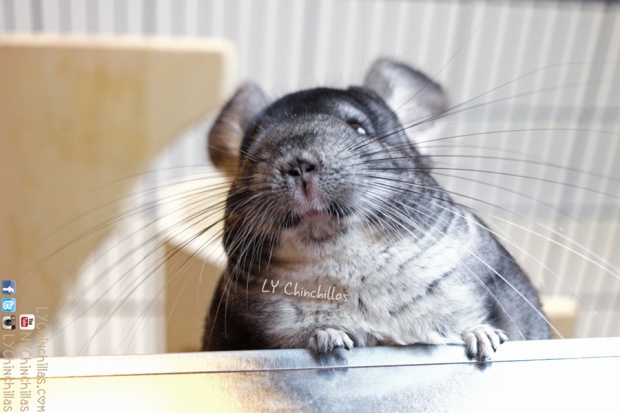 This is not to say that chinchillas can’t be properly introduced over time and come to be great mates – it’s only to say that your chinchilla does not need another chinchilla to live a long, happy life. This is a main point to consider. In my personal experience, every single one of my chinchillas (with the exception of the mosaic sisters Lulu and Fifi) live alone in their own cage and are living a healthy, satisfying existence. Do I wish they got along? Of COURSE! Did I try to bond them within reason? Definitely! Do I still have dreams? Forever and always. It’s my dream for all my babies to cuddle up and coo at me. However, it’s only a dream – that’s my reality, and that’s okay.
This is not to say that chinchillas can’t be properly introduced over time and come to be great mates – it’s only to say that your chinchilla does not need another chinchilla to live a long, happy life. This is a main point to consider. In my personal experience, every single one of my chinchillas (with the exception of the mosaic sisters Lulu and Fifi) live alone in their own cage and are living a healthy, satisfying existence. Do I wish they got along? Of COURSE! Did I try to bond them within reason? Definitely! Do I still have dreams? Forever and always. It’s my dream for all my babies to cuddle up and coo at me. However, it’s only a dream – that’s my reality, and that’s okay.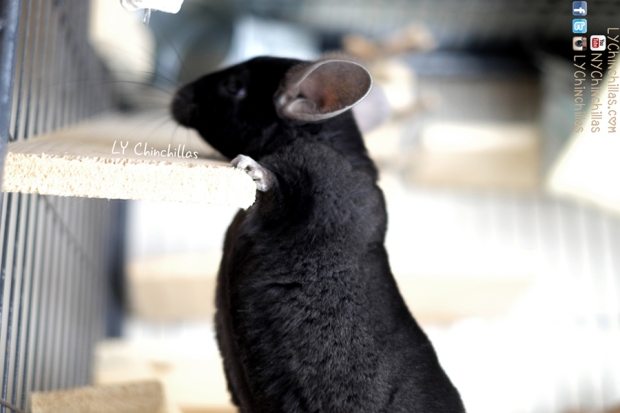 The only reason you should get another chinchilla is because YOU – as a responsible, capable owner – want to take on the duty of another precious life in your home. That means double the mess, double the work, double the expense, double the personality, and double the adorable joy that comes from each and every chinchilla. Be aware that your decision will impact YOUR life, your existing chinchilla’s life, and your new chinchilla’s life as well. The main focus should be the well-being of your pets, despite their ability to cohabitate.
The only reason you should get another chinchilla is because YOU – as a responsible, capable owner – want to take on the duty of another precious life in your home. That means double the mess, double the work, double the expense, double the personality, and double the adorable joy that comes from each and every chinchilla. Be aware that your decision will impact YOUR life, your existing chinchilla’s life, and your new chinchilla’s life as well. The main focus should be the well-being of your pets, despite their ability to cohabitate.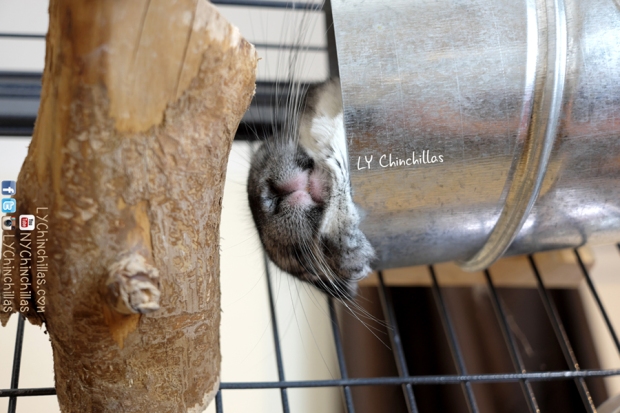 So, let’s say you’re ready to take the next step: another fluffy baby in the household! Great: congratulations for coming to this decision based solely on your willfulness to take on another chinchilla, understanding the great probability that he or she may not be able to live amicably with your current chinchilla. Bravo! What’s next? Firstly, if you have intentions to house your chinchillas together, you must purchase a chinchilla of the same sex (unless one of them has been fixed). Then, be sure to purchase all the necessities your FIRST chinchilla required: new cage, water bottles, shelves, hammocks, accessories, food bowls, and fleece! Do not pick up another chinchilla without first getting all the essentials that he or she may need. Never assume you can just plop him or her in with your existing fluffball – that could have devastating consequences for either or both babies. It’s also good to brush up on the basics for each new chinchilla, as no two are alike.
So, let’s say you’re ready to take the next step: another fluffy baby in the household! Great: congratulations for coming to this decision based solely on your willfulness to take on another chinchilla, understanding the great probability that he or she may not be able to live amicably with your current chinchilla. Bravo! What’s next? Firstly, if you have intentions to house your chinchillas together, you must purchase a chinchilla of the same sex (unless one of them has been fixed). Then, be sure to purchase all the necessities your FIRST chinchilla required: new cage, water bottles, shelves, hammocks, accessories, food bowls, and fleece! Do not pick up another chinchilla without first getting all the essentials that he or she may need. Never assume you can just plop him or her in with your existing fluffball – that could have devastating consequences for either or both babies. It’s also good to brush up on the basics for each new chinchilla, as no two are alike.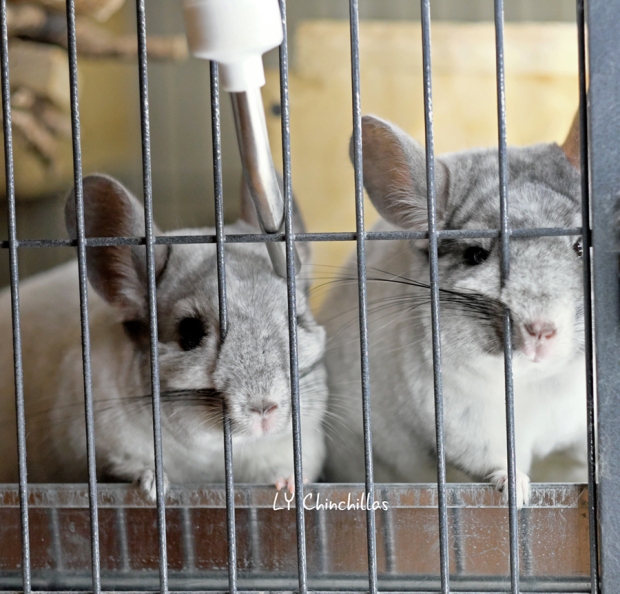 Then, you can introduce your chinchillas slowly to one another, placing their cages near one another to allow them to get accustomed to new smells and the new presence. I won’t go into the controversial topic of talking about how exactly to introduce your chinchillas, as there are plenty of suggestions out there and very strongly opinionated owners. The safest way that I have found is to place them in proximity to one another with a barrier and allow them to react to one another without having to fear for their safety. Based on their reactions initially and over time, you can safely determine how they might react with one another. In my experience, my boys got along until the ladies arrived, and the ladies never got along with one another (aside from the sisters, of course). I would never consider housing the males and females together because none of them are fixed, and I don’t have the capability to take care of any kits with my very full-time job if anything were to go wrong with the birth. I can’t stomach the idea of losing any of my existing babies, even to their babies.
Then, you can introduce your chinchillas slowly to one another, placing their cages near one another to allow them to get accustomed to new smells and the new presence. I won’t go into the controversial topic of talking about how exactly to introduce your chinchillas, as there are plenty of suggestions out there and very strongly opinionated owners. The safest way that I have found is to place them in proximity to one another with a barrier and allow them to react to one another without having to fear for their safety. Based on their reactions initially and over time, you can safely determine how they might react with one another. In my experience, my boys got along until the ladies arrived, and the ladies never got along with one another (aside from the sisters, of course). I would never consider housing the males and females together because none of them are fixed, and I don’t have the capability to take care of any kits with my very full-time job if anything were to go wrong with the birth. I can’t stomach the idea of losing any of my existing babies, even to their babies.
What I’ve learned is that my chinchillas are generally solitary animals, and I am their best human friend. I clean, scratch, and provide emotional support to them (oft via song), and they have shown me time and time again that they don’t need – and never needed – another chinchilla friend for them to live a loved, loving life. No, your chinchilla is not lonely or lacking. Are they bored sometimes? Maybe. But that’s what stimulating cages, safe chews, and occasional treats or playtimes are for! You can provide a beautiful, fulfilling life for your chinchilla – never doubt that. They do deserve a great mate, and I’m certain they can find that in you.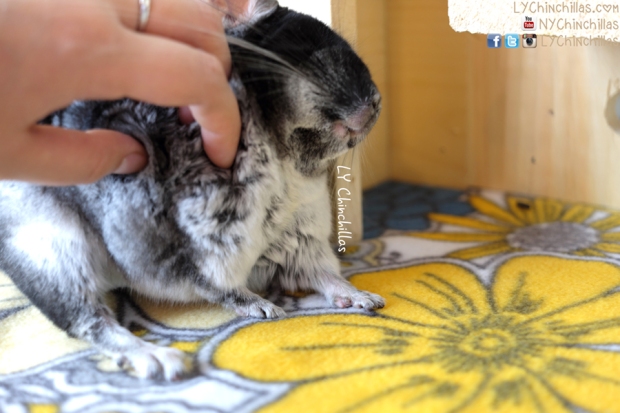

LY Chinchillas Treat Donation
Donate healthy, delicious treats to LY Chinchillas to help keep our content going!
$5.00
Well, it’s official: this autumn has been incredibly busy for the human (that’s me!). However, that doesn’t mean that I’ve been neglecting my babies. Life is all about priorities: the people, experiences, and fluffs that are meaningful in your life will rise to the top of your to-do’s and will always be accounted for. So, let me catch you up on some of the fun changes ongoing in the world of LY Chinchillas!

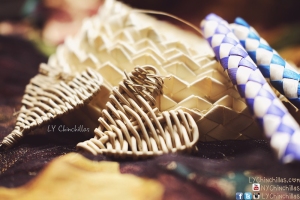
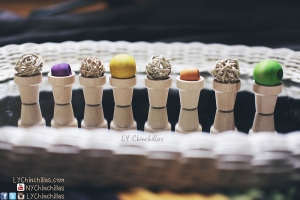
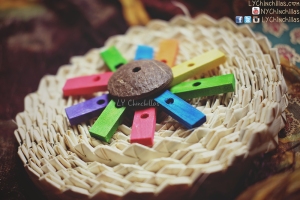 New DIY Goodies: I am a huge fan of DIY when it comes to the world of chinchillas: cages, toys, accessories, sourcing and preparing your own chin-safe wood (a list of safe wood can be found here), litter boxes, cookies, and more! Most recently, we’ve replaced our pine litter boxes, swapped out some older ledges for clean pine, and added in a slew of fun new hanging toys! It’s always great to make your own toys: it’s less costly than buying toys outright and allows you to be as creative as you want. I often dream up toy designs depending on each of my chins’ quirky personalities!
New DIY Goodies: I am a huge fan of DIY when it comes to the world of chinchillas: cages, toys, accessories, sourcing and preparing your own chin-safe wood (a list of safe wood can be found here), litter boxes, cookies, and more! Most recently, we’ve replaced our pine litter boxes, swapped out some older ledges for clean pine, and added in a slew of fun new hanging toys! It’s always great to make your own toys: it’s less costly than buying toys outright and allows you to be as creative as you want. I often dream up toy designs depending on each of my chins’ quirky personalities!
Always in Stock: While not such an exciting ongoing development, it’s important to mention that with chins, there come perpetual costs. Although pellets and hay are not that expensive if you buy in bulk, chinchillas are intellectual and emotional creatures that deserve (and need) a good deal of mental and dental stimulation. That’s why I always have a full stock of apple sticks, cholla sticks, pumice stones, rosebuds, rose hips, marigolds, shredder tape, and other delicious chew/treat options. Over the years, I’ve been able to curate a good balance of their favorite chew selections and make sure to award them for cuteness! This is all, of course, in addition to the plentiful hay and pellets included in a healthy chinchilla diet. Oh – it never hurts to remind everyone that I have two 26 oz water bottles per cage, and at least two extras on hand for replacement just in case. You never know, and water’s one of those fundamental necessities!
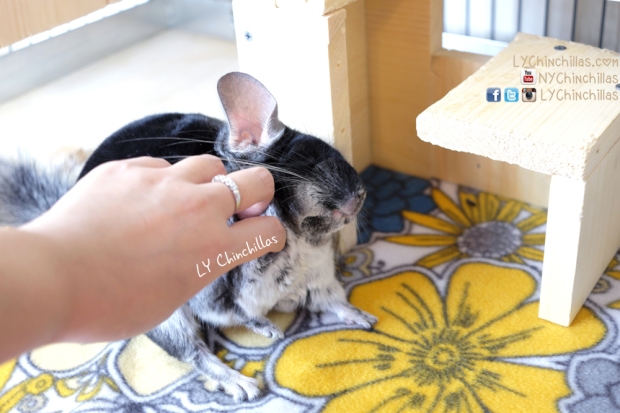 New Fleece: When the seasons change, so doth the fleece. While colors and designs bring a fresh new feel to their cages, it’s also important to discard fleece after a certain level of usage. Typically, when non-pill fleece starts to lose its original texture, that’s the sign to swap. Luckily, fleece ordered online is inexpensive and plentiful, meaning there’s tons of delightful – and affordable – designs to choose from!
New Fleece: When the seasons change, so doth the fleece. While colors and designs bring a fresh new feel to their cages, it’s also important to discard fleece after a certain level of usage. Typically, when non-pill fleece starts to lose its original texture, that’s the sign to swap. Luckily, fleece ordered online is inexpensive and plentiful, meaning there’s tons of delightful – and affordable – designs to choose from!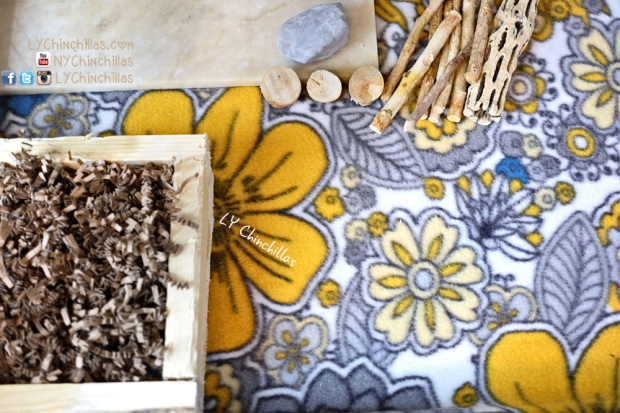
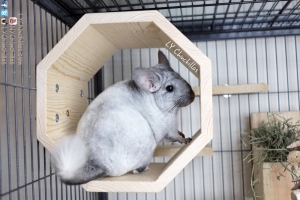
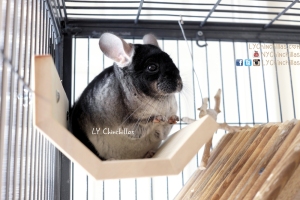
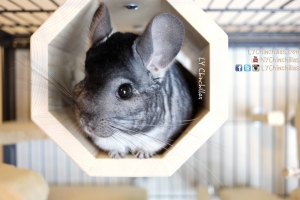 New Accessories: Not only have we re-stocked on some fun hammocks for Muff and Koko, but we’ve also been fortunate enough to have discovered a new chinchilla vendor – Whisking Woodworks! Creator Robyn is a young furniture designer and chinchilla lover in Seattle, WA, and Whisking Woodworks is all about creating unique chin-safe accessories for fluffy friends. Be sure to visit her website and check out the beautifully crafted octagonal furnishings – perfect for the contemporary, modern, or spunky chinchilla! 😛
New Accessories: Not only have we re-stocked on some fun hammocks for Muff and Koko, but we’ve also been fortunate enough to have discovered a new chinchilla vendor – Whisking Woodworks! Creator Robyn is a young furniture designer and chinchilla lover in Seattle, WA, and Whisking Woodworks is all about creating unique chin-safe accessories for fluffy friends. Be sure to visit her website and check out the beautifully crafted octagonal furnishings – perfect for the contemporary, modern, or spunky chinchilla! 😛
As far as existing shelving and ledges, a super helpful tip for a super busy month: if you’re unable to make it out to refurnish your chin’s kiln-dried pine, simply flip your less-than-perfect ledges upside down and re-adhere! You’ll be set for at least a few weeks while you get ready to hit up the local lumber supplier. Over the years, I’ve found it’s much more convenient to buy large quantities of kiln-dried pine in bulk and properly store goods in a dry, clean environment until you’re ready to create some delectable chinjoyable structures! You never know, inspiration can hit you like a 50 lb. bag of blue cloud dust, so the basics are great to always have on hand.
Holiday Photos: Yes, it’s almost that time of year again, where the elves of the world ready their cameras for prime-time-chinchilla-photoshoot time!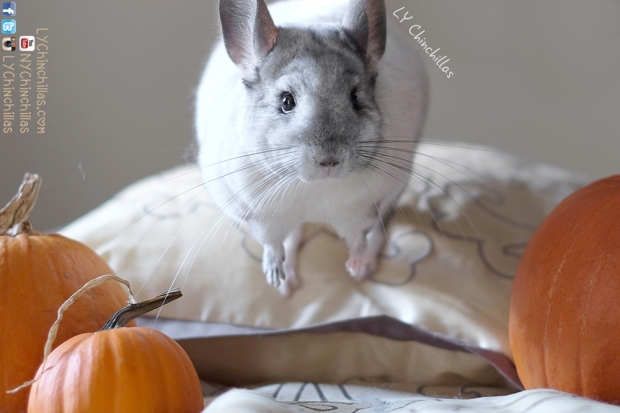 While we’ve only managed to grab a few pumpkin and autumn-themed captures, we are keen on remaking horror movies and having some spooky fun (click the link – you won’t be disappointed by Mitty’s acting debut)! But definitely, be on the lookout for some Christmas-themed goodness headed your way, direct from the five flooferoos! 🙂 Have a wonderful month, fluffs and fluff-lovers!
While we’ve only managed to grab a few pumpkin and autumn-themed captures, we are keen on remaking horror movies and having some spooky fun (click the link – you won’t be disappointed by Mitty’s acting debut)! But definitely, be on the lookout for some Christmas-themed goodness headed your way, direct from the five flooferoos! 🙂 Have a wonderful month, fluffs and fluff-lovers!

LY Chinchillas Treat Donation
Donate healthy, delicious treats to LY Chinchillas to help keep our content going!
$5.00
As a chinchilla owner, sometimes the world beckons you away from the life of a stay-at-home chin-slave guardian. When the sweet oceanside breeze or faded sirens of some delightful foreign city tug at your heartstrings, you begin to remember what life was like before owning a chinchilla.
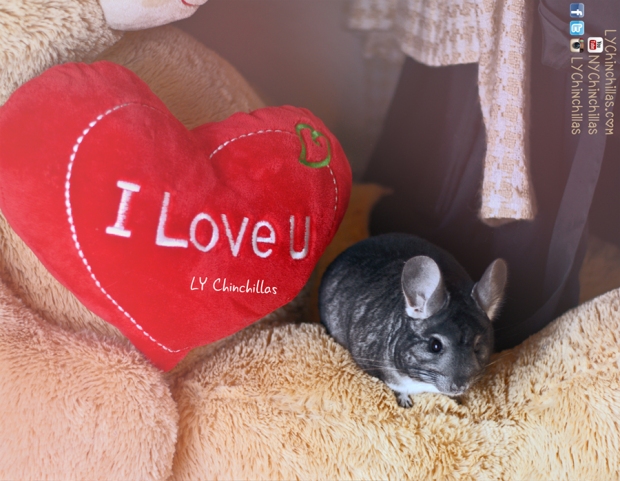
All the feeding, cleaning, dusting, weighing, and constant bonding efforts can get overwhelming at times – not to mention the cage building, cage purchasing, DIY cage accents and hanging toys, cookie making, perpetual safeguarding against plastic, hefty air conditioning/dehumidifier bills, and constant provision of chin-safe chews, occasional chin-proofed playtimes, and continual supply of soft entertainment. And if you think that’s a handful, it’s just the start! For very loving chin-owners, chinchilla ownership is a way of life and chinchilla care and parenthood is just as much a part of your daily routine as work, friends, or school! They’re family! Honestly, caring for a chinchilla properly is time, energy, and money-consuming, but that smug smile on their fat, furry faces is worth every ounce of trouble! For new or potential owners, just go ahead and skip to our post all about chinchilla care basics to gather a light gist of what your fluffy workflow will be like.
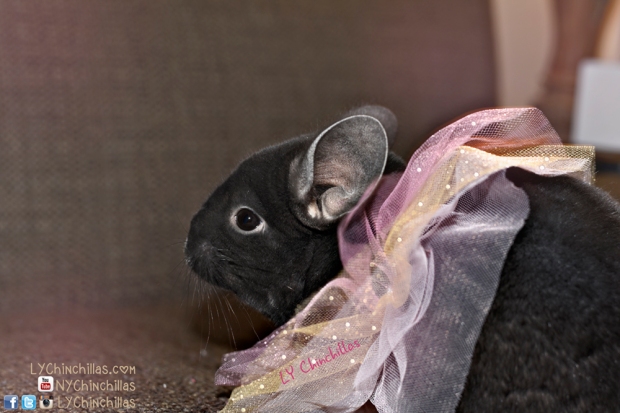
So, back to that wanderlust dreamscape: island sunrise, countryside mountaintop, or city retreat. Maybe you’re thinking of leaving for a weekend, or flying off for a few weeks – after all, you’re a hardworking chin-parent, you deserve it! What’s the best course of action when you can’t take your babies with you? Let’s chat about chin-sitters! Inevitably, at some point in your chin’s very long and happy life with you, you will likely have to leave your beloveds in the care of a third party. This post is all about how to select and direct the perfect chinchilla sitter, and make sure your fluffs are well-cared for in your bittersweet absence.
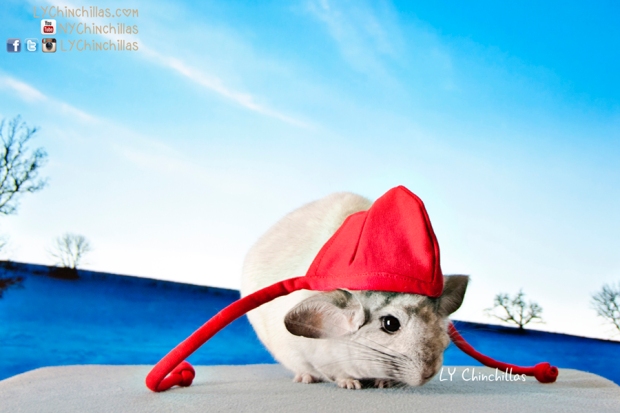
Step 1: Find your potential sitter. I’m lucky: I have an incredible family that lives close and are well-versed with my chinchilla obsession – they’ve endured endless lectures from me on chinchilla health and safety. Ideally, a family member or very close friend would be the best choice – someone who lives nearby, so you always have a reachable emergency contact. It’s best to find a sitter well in advance, as it’s all about availability and suitability.
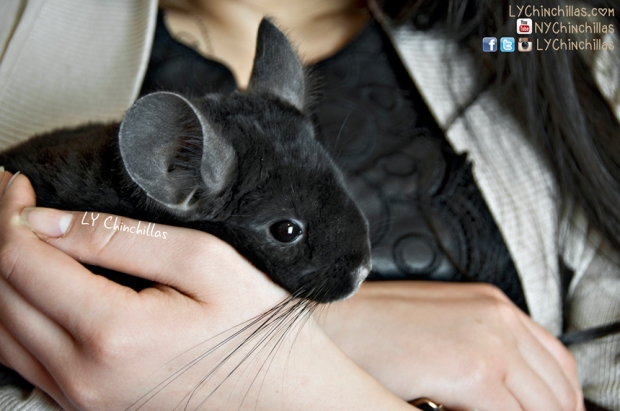
Step 2: Provide all necessary information to your sitter. I make a very thorough document touching on all major points, as well as directing them to this blog to find additional information. Of course, they can contact me at anytime through any social media platform, phone, or email in order to obtain additional information. Adding in the number of your exotic vet is always a great move, too. I always try to drive home the idea that this incredibly important document will be their chinchilla bible for the duration of their stay. Instructions should typically be much more conservative than the way you care for your chins, taking into account the differentiation in familiarity and knowledge of your particular chinnies.
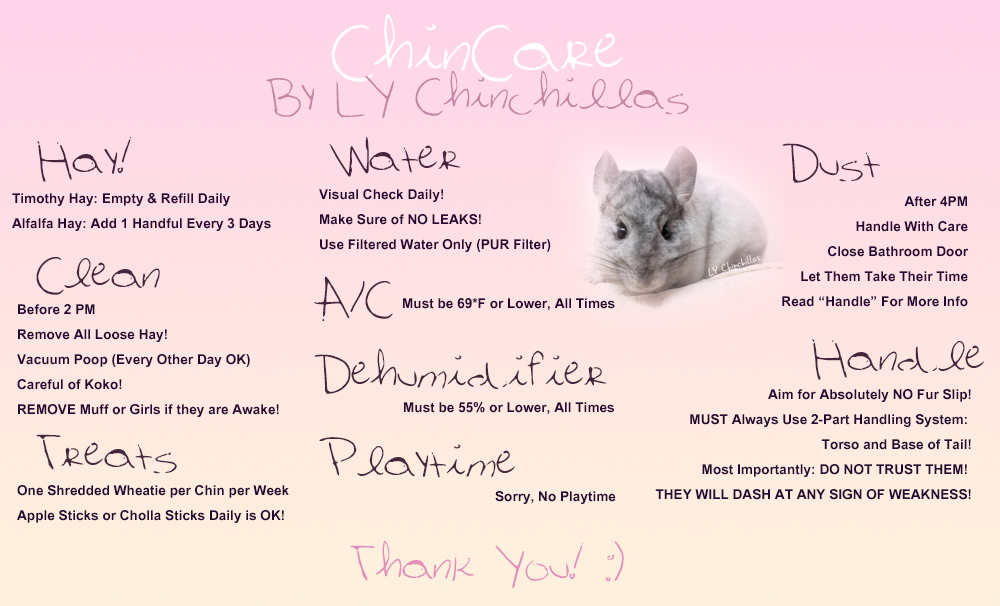
Step 3: Test your potential sitter. After allowing sitters to review information, I’ll invite them over each day for several days in order to test their ability to handle, feed, dust, and care for the chins. I typically skip imposing the daily weighing routine while I’m away, as it is more involved than the other care elements and requires a deeper understanding of each chinchilla in order to successfully weigh them. I’ll always ask a few questions as I watch them work, including a few “what if” situations for good measure.
I was asked recently about why my playtime rules are so conservative. To elaborate, I’m all about playing it safe with my babies – especially given new circumstances, people, or events. Too many things can go wrong if your sitter isn’t completely trained for playtime, so I err on the side of caution. Every chinchilla is unique, and some are crazier than others (cough, Muff!); each new variable equates to a slew of new, potentially harmful results. Playtime is, in general, optional based on the opinion of each chinchilla owner. Additionally, playtime is not crucial in any means to a chin’s general health, so skipping a few sessions couldn’t possibly hurt them. On the other hand, overheating, fur slip, stress, or injury could. The most nightmarish situation I could think up would be a chinchilla injury occurring while I’m not home with no concrete proof of how, why, or when. I’d personally wait until I was home to conduct any playtimes, but everyone is different! Who knows, you could know a true chinchilla guru – but that would still be a risk you’d have to be willing to take as a responsible pet owner.
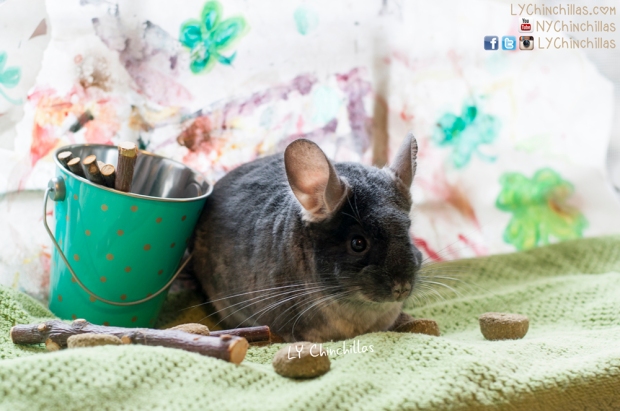
Step 4: Buy a webcam! This is a great piece of technology that every chinchilla owner should buy, as it captures what your chin-sitter may neglect. I position the cam between the cages and angle the cages so I can see everything: water bottles, hay feeders, pellet bowls, and so on. Additionally, I’ll always position my thermometer close enough to the webcam in order to monitor their environment from afar. I have a webcam that’s easy to check via phone and even allows me to coo or sing to them from another zip code!
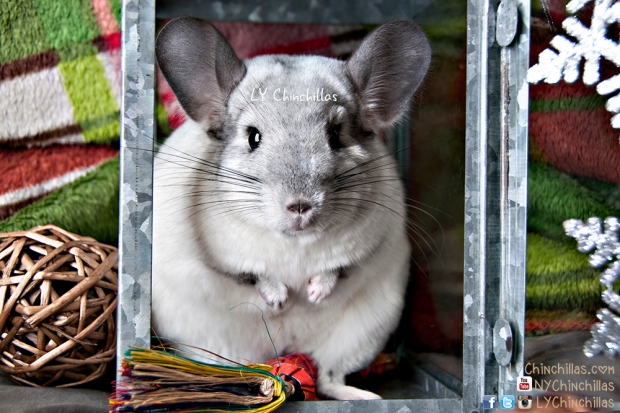
Step 5: Check in with your sitter every day. Text, call, or email! A short catch-up on your chin’s day is always in order. Of course, you can also inquire about how your sitter is doing! 😛
Step 6: Pay your sitter (with friendship, or money). Payment for quality service is always a gesture of goodwill. 🙂 Unless we’re talking family – in that case, put it on the communal tab.

Step 7: Keep in contact and repeat as needed! As the sourcing part of this process can be quite intense, it’s best to maintain great relations with your chin-sitter and keep in touch, as you never know when your travel bug will catch up with you again.
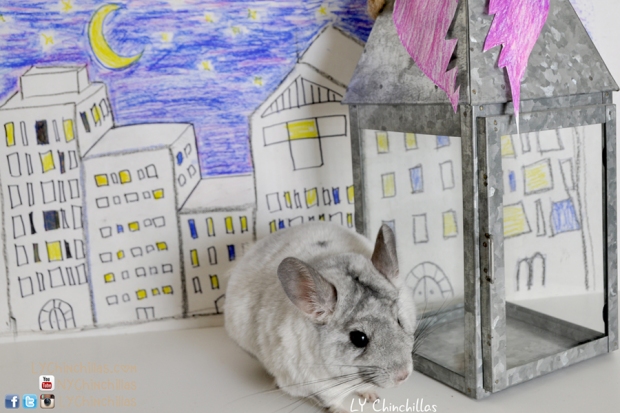
There you have it; the 7 steps to take when selecting and utilizing a chinchilla babysitter. Of course, use your sitters as sparingly as possible: chin-sitting is time and energy consuming, and only you know your chins best! 🙂 As with all exotic pets with specific needs, chinchillas require very willing and knowledgeable sitters, but most pet lovers can be trained with adequate time and accurate information over time. Happy travels, chin-lovers – and make sure your lovely fluffs are safe at home for when you return!

LY Chinchillas Treat Donation
Donate healthy, delicious treats to LY Chinchillas to help keep our content going!
$5.00
Hanging toys: the cutest, most heartfelt way to watch a chinchilla struggle without a twinge of guilt! They’re also dental-friendly treats that keep your fluffs engaged and entertained during long work or school days. I love chinchilla-safe woods and chews because they are a fabulous non-food way to make your chins happy and show them that you care – not that they need even more from you to be spoiled with! But really, just one more chew toy couldn’t hurt.. (and seriously, it couldn’t!) 😛 So, today’s post is all about how to make DIY hanging toys!
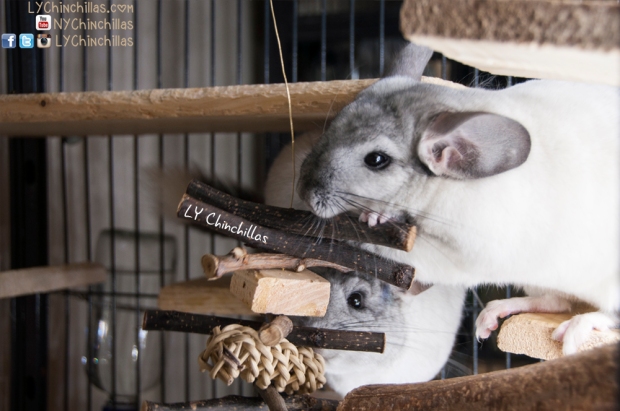
There are only a handful of tools that are needed to make a very simple hanging toy:
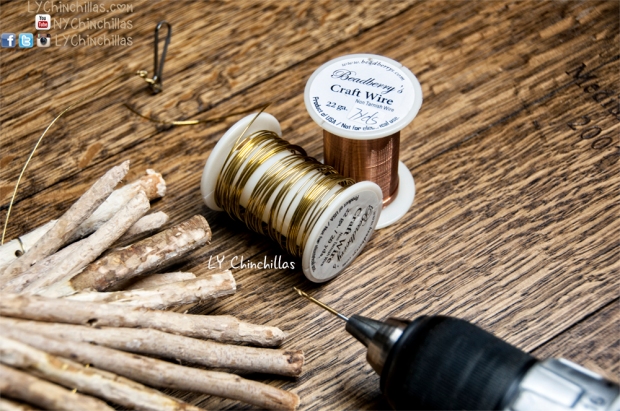
The first step is to gather your goods! We use apple sticks, pear sticks, chunks of pine, and vine twirls – but some all-time favorites include natural loofah, blocks of pumice stone, shredder tape, and more! Feel free to read about chinchilla safe woods and chews to get some ideas for your own custom toys. Over time, you’ll come to realize which woods or chews your chins prefer. Another great tactic is to use the barkless wood that your chins have already partially demolished; it’s a thrifty way to re-purpose the seemingly unwanted sticks (they’ll be slower to go at them, but they’ll begrudgingly get to it eventually). Then, I drill through the center of the wood, but wood vendors tend to sell pre-drilled wood for easy toy-making.
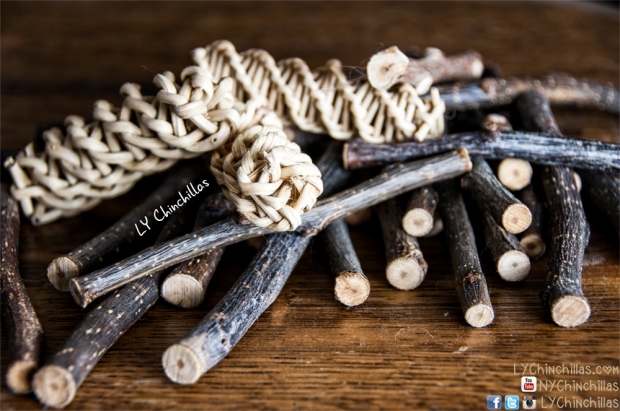
The next step is to cut your wire to the desired hanging length, adding on a little extra just in case. I typically cut the wire to 12″ and remove any extra length prior to finalizing the toy. It’s important for your wire to be made out of a solid metal to dissuade exploratory chewers (although they’re typically too preoccupied with the hanging toy to consider munching on the wire). Another great way to put your mind at ease is to either fill the wood to the very top so that there is no exposed metal, or to hang the toy strategically so that the exposed area is not reachable. I have seen other varieties in toy-making such as seagrass or chains, but it ultimately depends on what you know to be the safest, best option for your particular chins. So far, there have been zero issues with our construction and the final products are spot-on for my five furry babies.

For the top of the toy, I’ll wrap the wire tightly around the hook, using pliers to tuck the edge away. Since we go through faulty glass water bottles every few months, I make sure to keep the hardware for hanging toys – the hooks are perfect for the cage bars, because they’re made for just that! Another good alternative would be shower hooks, as they’re self explanatory and easy to work with.
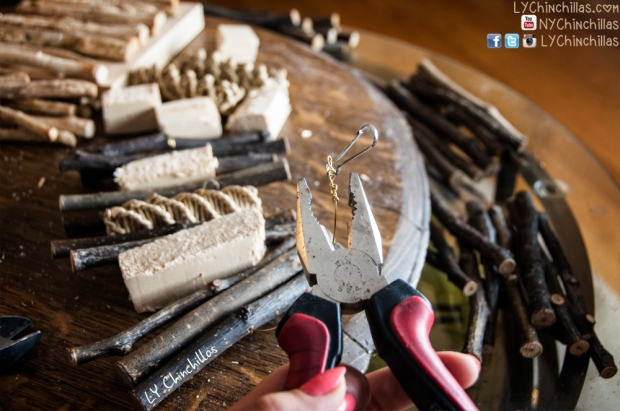
The funnest part for me is next: to string all the toys on the wire in my favorite order! I like to mix up the different woods and chews to offer some variety for the chins – plus, they look really nice when they have some diversity to them.
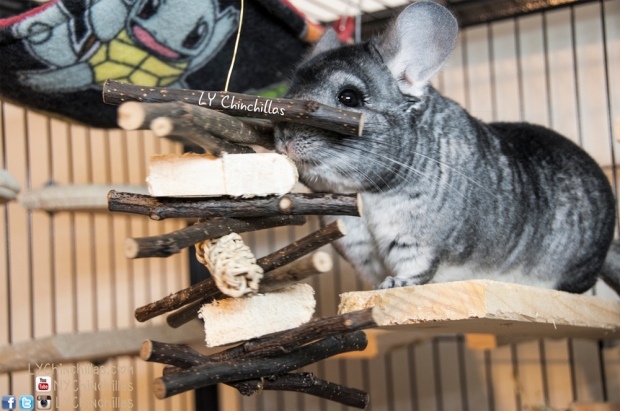
The trickiest and final part is to close off the hanging toy. If you’re using a thicker wire, you can simply use pliers to close off the toy in a “U” with the wire and call it a day. Using a thinner wire is easier to work with initially, but is a tad tougher to close off. The way I do it is to string the wire through the last stick – enough slack for the wire to wrap around the stick twice – and thread the wire through the hole a second time, pulling the wire flush to the stick. Because this type of craft wire is so malleable, it will secure itself easily after being pulled and be unable to be readjusted without pliers. The last step is to cut the excess wire flush with wire cutters or strong scissors (although after a certain amount of practice, you’ll be able to calculate the perfect amount of slack not to need to cut the wire at all).
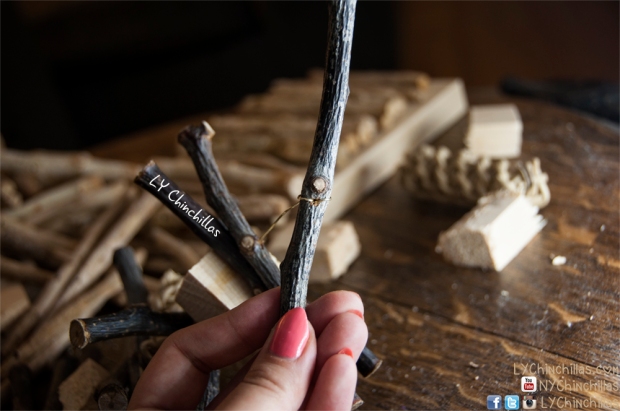
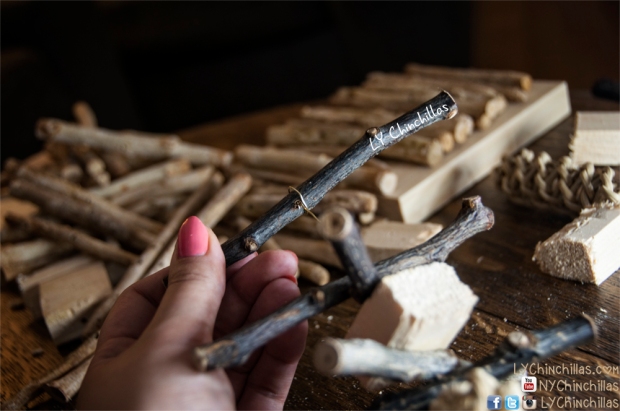
And voilà! There we have it – hang away and watch your happy chinchillas struggle with sheer delight! 🙂 The more toys you make, the more endless variety you’ll find that there is! You can make toys in all different sizes and shapes – the fun is being able to take some time out of your day and do something that takes your mind off of how much money, time, and energy you spend on your chinchillas by creating something lovingly by hand for their spoiled enjoyment!
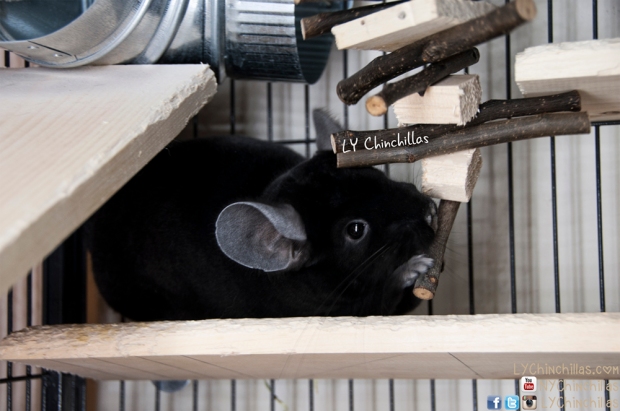

LY Chinchillas Treat Donation
Donate healthy, delicious treats to LY Chinchillas to help keep our content going!
$5.00
An often overlooked part of chinchilla ownership is the cleaning. Let’s face it: it’s not the cutest thing to talk about, but it’s an absolutely crucial part of caring for your chinchilla and maintaining their continued well-being. Everyone’s cleaning schedule varies depending on their own routines and lifestyle, but I want to share my daily cleaning routine with you. This is also a great post to help new or potential owners understand chinchilla basics a little better in order to best plan for chinchilla ownership.

It’s important to touch on why cleaning is important. It may seem self-explanatory, and it is, but it’s always good to revisit the “why”s of it all. Not only is good hygiene attributed to a higher quality of life, but cleanliness can often prevent illness and infection, leading to better health and perhaps even a longer lifespan for your chinchilla.
To start, I have tried different cleaning routines and techniques, depending on the cage structures and how busy my life gets. Luckily, I work remotely and am able to spend a great deal of time around my chins, which has allowed me to streamline the techniques I use to care for them. Once your chinchilla routines have been developed and well-practiced, you can be confident of your ability to do your job as a chin-parent regardless of the type of day you have. Not everything will work right away, and sometimes you’ll need to step back and reevaluate your ratio of energy input to cleanliness output, but that’s all part of being a parent and doing the work it takes to make your life easier, minimizing effort and maximizing reward.

My chinchillas are the sleepiest from 11 AM to 3 PM, making that window of time the best for cleaning. My first step is to assess the damage and complain with a seasoned acceptance of reality. I’ll remove all loose chew toys and cuddle buddies to make sure they are safe from the cleaning process. Then, I’ll use my paws to gather and discard all loose hay that has fallen on their cage floor, as pieces of hay aren’t part of my vacuum hose’s vocabulary. The last in-cage step is to vacuum out all poop to the skeptical pirate eye of a half-sleeping chinchilla. I use a bagless upright vacuum with a stretchable hose, although shop vacs work just as well. I advise against handheld vacs, as I’ve yet to find one able to adequately accomplish even one session of light cage cleaning. Finally, I’ll sweep up the floor around the cage, collecting fallen poop and hay. This also a great time to replace litter box bedding or refresh hay and pellet supplies. For all four cages, this process takes roughly 45-60 minutes a day. While it seems like a lengthy process, it’s much more preferable to me than allowing a larger mess to accumulate, both due to my unwillingness of having to tackle a larger mess and because I truly believe this daily cleaning routine is a chore of parental responsibility that I owe to my chins (although I do dream of them one day being able to clean their own spaces. And talk to me. And fully comprehend a chin-mama’s struggle).

Before Cleaning: The Daily Mess

After Cleaning: The Restoration
If I’m not able to make this time bracket, I’ll schedule in cleaning at a time that’s more convenient for that day. I have a smaller cage space with a running wheel that the chins use for exercise sessions, time outs, or these types of cleaning sessions. It’s a brief 10-15 minutes in which they can enjoy (or abhor) the smells of the other chins that have occupied the cage before them, burrow under an excess of bedding, or go for a jog. I also keep a water bottle and bowl of pellets adhered to the cage, just in case someone wants a quick bite or sip.

On a weekly or bi-weekly timeline (depending on which chins are litter trained), I’ll wash out their fleece liners with hot water and vinegar. I hand wash and air dry, as I don’t have my own laundry unit (this is New York City, after all) and I’d rather be hands-on with the chinchilla maintenance process. During this time, I also clean the steel pan foundation of each cage with a water, vinegar, and lemon mixture (50% water, 40% vinegar, and a splash of lemon). Lemon and citrus on their own are harmful to chinchillas, but the acidity in lemon juice can be great for getting out the grime – it’s necessary to thoroughly rinse and dry all items that use this mixture, rendering the mixture chinchilla-safe. It’s important to maintain all cage items, including fleece, pans, platforms, ledges, and accessories – it’s the surest way to get the most value out of your cage investments!

It’s my theory that the time spent with my chinchillas is never enough, and that bonding practices are forever tasks and never a lost energy. As a chin-parent, your work is never done! Don’t get overwhelmed or discouraged; this is all part of the beautiful journey of chin ownership. Cleaning is a really amazing time to check your bond with your chinchillas, building trust and allowing your chins to familiarize with your presence. This ritual can also be critical to build a baseline level of interaction; over time, you’ll become familiarized with daily behaviors and potential aberrations that require further observation or attention. Eventually, you’ll even bring comfort to them with your shared routine. You’d think that a screeching vacuum and clanking human would illicit a greater reaction than a slight eye peep, but all my chinchillas are so comfortable with our daily routine that they are happy to slumber luxuriously on despite their maid’s – err, I mean mom’s struggle. 🙂


LY Chinchillas Treat Donation
Donate healthy, delicious treats to LY Chinchillas to help keep our content going!
$5.00

In tandem with recent posts about Ferret Nation Cages and How To: Build a Custom Chinchilla Cage, this post is all about cage details – all the necessary components that help make your chin’s cage feel like a meaningful, functioning home! Although there are online vendors for listed accessories, all items that are realistically able to be made at home have been described in a DIY manner.

Platforms & Ledges: I suggest keeping platforms 4-5″ wide, installed under 6” apart height-wise for safety. Any higher, and a fall could potentially hurt your chin. And don’t forget ledges – fun shapes for corners, sides, and all around. Sizes can vary, from 3″ upward. The hardware part is simple: screws, washers, and a drill will keep your items snug and secure.

Hay Feeders: Hay is an integral part of any healthy chinchilla diet, and it gets everywhere! Our cages have DIY hay feeders, complete with a standing perch for easy eating. Connected with two sturdy hooks, these feeders are a chin favorite, adhere to horizontal bars with ease, and keep the mess minimal!
Food Bowls: We recently switched from bottom-heavy bowls to stainless steel bowls that adhere directly to cage bars. It’s been a wonderful transition, as the stainless steel bowls are sleek, safe, attractive – and most of all, easy to use.

Litter Boxes: Read this post all about DIY litter boxes and litter training! Litter boxes can be a tidy addition to your chin’s cage, encouraging your pets to maintain their space and keep clean. Of course, not all chinchillas can be litter trained, but it never hurts to try.

Huts & Houses: The fluffs love hiding houses, tight corners, and crunching down on the very infrastructure they inhabit. The best way to inhibit this type of behavior is by encouraging it in a safe, healthy manner! Our hideaways are made from kiln-dried pine and offer privacy-seeking chins a lovely respite from the craziness of their peaceful environments (because we all know being a well-cared-for chinchilla is exhausting). 😛

Stone Cooling Tiles: Our chins prefer marble or granite cooling tiles; they are a great accessory for the active buggers who dart all over their cages, working up some heat! The tiles offer temporary relief for warm tummies, but only act effectively if hand-in-hand with low temperatures or air-conditioning.

Hanging Toys: Hanging toys are quite simple to make, and shockingly fun to watch as your chins swing them from side to side in impatient demolition attempts. Some drilled apple sticks, chunks of kiln-dried pine, and pumice stones make for a really great time – especially for the attention deficit types!

Hammocks and Tubes: While not every chin enjoys hammocks, a lucky few really do love lounging in comfy floating fleece blankets. There’s nothing like a softly swinging sleepy chinchilla to bring a smile to your face! Tubes are also great accessories, offering a round retreat for your fluffballs. I use galvanized steel ducts, which have rounded steel that can be used safely without fleece coverings. Other tube options include PVC or cardboard tubes with snug fleece covers to prevent harmful ingestion.

Cuddle Buddies: Fleece teddies can be perfect for solo chinchillas! As long as the cuddle buddy has fine stitching and good construction, your chin will be snuggling up next to their new friend (or tossing it around) in no time.
Water Bottle: Water bottles are the bane of my existence. As I’m living in the city, I do not have an adequate setup for a water pump system. So, I run through glass water bottles every few months. I always have two water bottles in each cage, a 32 oz. and an additional 16 oz., just in case. Currently, I use Kaytee, Living World, and Lixit (although I’ve tried more than a handful of brands), and simply cross my fingers. I have never understood why water bottles do not have any type of manufacturer’s warranty, as they are often faulty and fail to stand the test of time.

Running Wheel: Although chinchillas do not require a wheel, it is nice to have one for exercise purposes. My chins have a running wheel in a separate playtime cage, which is an excellent way to encourage a weekly allotment of exercise while teaching them to manage their stress when being introduced to different environments.

Fleece: The safest fabric for chins, fleece is a good way to cover up harmful plastics in your cage or line the bottom of your cage with a pretty pattern. While fleece is not necessarily easier to clean than bedding, it does help make your chin’s home more personal. If your chin is litter trained, I suggest washing fleece every 2 weeks with a hot water and lemon juice/vinegar mixture. If your chin is not litter trained, fleece should be washed weekly to prevent urine buildup. It’s important to note that while most chins do not eat fleece, some will try! If that’s the case, then fabric should be removed immediately to prevent consumption.

Custom Steel Pans: Galvanized or stainless steel pans for your chin’s cage are an awesome investment – they are easy to manage and long lasting with proper care. Swapping out plastics for steel is a simple way to prevent harmful ingestion, blockage, or impaction that can come with gnawing malleable plastics.

As always, try to incorporate safe woods into your chin’s environment, and understand the importance of choosing wood over plastic. Be sure to always have an air-conditioning unit (or two!) during warm months, keep a regular dusting routine, and monitor your chin’s weight for changes in consumption in order to catch early warning signs of illness. 🙂


LY Chinchillas Treat Donation
Donate healthy, delicious treats to LY Chinchillas to help keep our content going!
$5.00
When it comes to chinchilla care, all owners understand – or will eventually come to understand – the negative risk associated with plastic consumption. It’s too easy to turn a blind eye to this issue, as pet stores and manufacturers across the world push its occupants towards plastic for an obvious profit. It’s cheap, easy to produce en masse, and nearly indestructible – except when it comes in contact with a determined set of chinchilla chompers. Today, I’m raising my digital paws to the sky and asking all chinchilla owners to please – for the love of fluff – switch to a chinchilla-safe wood alternative.

Plastic consumption can cause blockage or impaction in a chinchilla’s digestive system, causing discomfort, pain, or even death. Sure, we’ve all had experiences of miraculous chinchilla digestion: for example, Muff, why are you drawn to chewing fabric? Why does it enchant you so? Why must I chinchilla-proof my outfit before handling you? 😉 I will say that my chinchillas have had their share of quirks and unsafe behaviors, but their mishaps are always recognized, seriously addressed, and prevented until the behavior is eventually resolved. But the simple relief of your – or my – chinchillas being safe after an unsafe behavior is no indication of future success. Yes, plastic can kill your chinchilla. I mean, it probably won’t, but it can. And putting your chinchilla in a potentially dangerous situation when you have the power to chinchilla-proof their living and playing space is simply unnecessary. As good owners, it is our responsibility to take the care of these fluffy lives very seriously and get rid of the plastic.
But how can we go on? How do we really live in an affordable manner without plastic? I mentioned in my Ferret Nation post that when it comes to cost-effective production, the small animal industry too often turns to plastic. Outside of cage fabricators, there are also major manufacturers pushing cheap dust houses, running wheels, litter boxes, hideaways, water bottles – plastic, plastic, plastic. As small of a media sector as there is for the small animal community, we need to stop listening to the part of it that is telling us to put perceived low cost and ease of purchase over the health and well-being of our animals.

The answer is, we need to shop differently and stop the flow of plastic consumption. Stop by Home Depot or a lumber supply, grab some cheap kiln-dried wood, screws and washers, and learn to make some simple things for your chins. And yes, it is actually cheap – as cheap or cheaper than plastic, and far more healthy both in the interim and long-term. Another DIY option is to cover plastic items tightly in fleece, a safe way to modify existing plastic items. A great way to think about improving your chinchilla’s environment is to look at the process as a positive bonding experience – a way for you to give your energy to your fluffy child in a way that they can truly appreciate. As chin owners, we really don’t get to experience a silent cuddle without any signs of struggle, so watching your chinchilla enjoy their well-made home is truly an expression of appreciation for all the work that you’ve done. And yes, we know that you have done a lot of work, and the work ceases to end, especially if you’re doing a great job.

Or, a less energy-consuming alternative: find a vendor that makes safe chinchilla ledges, platforms, houses, and accessories. There are plenty of great home-spun chinchilla vendors that put a lot of work and energy into making some beautiful accents for your chinchillas so you don’t have to! I will note, however, that when energy goes down for the end user, cost will tend to rise: the cost of purchasing from these vendors is almost always at least double the cost of producing these goods yourself (although a lot of people don’t want to make the initial investment of purchasing a drill, saw, and other construction materials needed to start on projects that require energy and attention, which I also understand). But honestly, if you aren’t going to break out the tools and do it yourself, by all means – buy from these vendors. It’s a higher cost than plastic, sure – but it is invaluable for your chinchilla to have that safe, healthy environment that he or she needs. The investment is not short-term, and it’s important not to lose sight of that.

Since the chinchilla pet owning market has not really spoken out against plastic in mainstream commercial avenues (i.e. endorsed by major chinchilla-selling pet stores) most creators of chin-safe goods will be sold at a premium. The more we evolve and begin to understand the chinchilla on a national scale – their complexities, individuality, health requirements, and all the basics – will we begin the full evolution of a safer, inexpensive, more comprehensive chinchilla market that gives our fur-babies exactly what they need, at a cost that won’t break the bank.
We already do so much for our chins, the least the industry could do is recognize and proliferate the true requirements that chinchillas need so as to promote ownership that is not ignorant for a lack of preliminary information. Ignorance will continue in each and every pet kingdom, that’s just the unfortunate truth. However, we should do our best to dissuade unfit owners through education and knowledge. I know the knowledge is out there, and amazing owners and breeders contribute to the chinchilla society, but too often the contributions are laced with a high-strung attitude about best practices. Don’t get me wrong, I’m not a person without opinion, and I definitely feel that there are a great many ways how to raise a chinchilla and a great many ways how not to. But I think there needs to be an open dialogue with the community – chinchilla owning and not – about chinchilla ownership and coming to an understanding of general chinchilla needs, and having that conversation turn into a pedestal for future expansion of the industry. The lack of a centralized commercial understanding of chinchilla care – or the willingness to promote bad care in exchange for profit – is unacceptable.

For my chinchillas, I make everything out of kiln-dried pine, from litter boxes to hay feeders to ledges, platforms, and toys (toys are often made from a variety of vendor-purchased pear or apple woods). I use stainless steel bowls, glass water bottles, and metal pans with fleece covering as a replacement for the stock plastic components in my cages. But then again, I’m just one loving chinchilla owner, and I can only do so much for the community at large. Chinchilla education starts with you, learning and sharing and learning again. There’s an endless ocean of information out there, and it’s spectacular. I spend a lot of my free time reading and learning and searching for more, for the simple reason that I care about chinchillas and would like to know more. Don’t be afraid to be wrong, but always try to fix your mistakes and practice great caution before making any decisions or setting your mind to some half-fact that could negatively impact your chinchilla. Knowledge is always power: the type of power that leads to a happy chinchilla home. Also, don’t get discouraged if you can’t do everything at once: making improvements is a process that expends time, money, and energy. You learn about what works best for your chinchilla, making positive changes whenever you can.. and every step counts.
Providing a happy home is, above all else, providing a healthy home. The happiest home is an environment that allows your chinchilla to explore their personality, growth, and development in a space that fosters and caters to their safety and health. I urge all owners to get rid of plastics inside your chinchilla’s cage and replace them with delicious, crunchy, dental-health-promoting chinchilla safe woods! 🙂

Muffton sleeping like a baby in his safe wood litter box! He might not use it as he should, but enjoys it all the same!

LY Chinchillas Treat Donation
Donate healthy, delicious treats to LY Chinchillas to help keep our content going!
$5.00
On the other side of winter, at last! The flowers are bursting into full bloom, the wind spins with a warmer embrace, and the sun basks our relieved faces. Yes, this is the start of the warmer season: spring, into summer, and eventually, autumn. This time of year spurs great activity, fun times, and for chinchilla owners, the annual realization that your electricity bill is about to jump! Yes, air conditioning is the only way to ensure your chinchillas will be enjoying a safe and healthy environment, and it’s a cost that simply cannot be discounted.

Excerpt from Chinchilla Basics 101: “Temperature: chinchillas can overheat at temperatures over 75°F, as they do not have sweat glands. Chinchillas have 50-100 hairs per follicle, as compared to a human’s 1 to 1 ratio. They are built for high altitude, cold environments with very low humidity. Owners are responsible for recreating that environment – it’s suggested to keep your chin’s living space between 60 and 70 degrees Fahrenheit (still comfortable for owners, safe for chinchillas). Red ears are a sure sign of overheating: if your chinchilla is too hot, be sure to place him/her in a cool environment with a cool slab of granite and closely monitor his or her water and food consumption. Be sure to always have a 24-hour exotic vet’s contact information on hand, in case of emergency.“

For those living in a temperate environment, here are a few basic pointers that can help with your chinchilla care regime during spring, summer, and hot autumn months. For those living in warm environments year-round, these tips can serve to help you maintain your chinchilla’s health.


LY Chinchillas Treat Donation
Donate healthy, delicious treats to LY Chinchillas to help keep our content going!
$5.00